History Of The Magnificent DC-8
20 September, 2024
29 min read
By joining our newsletter, you agree to our Privacy Policy
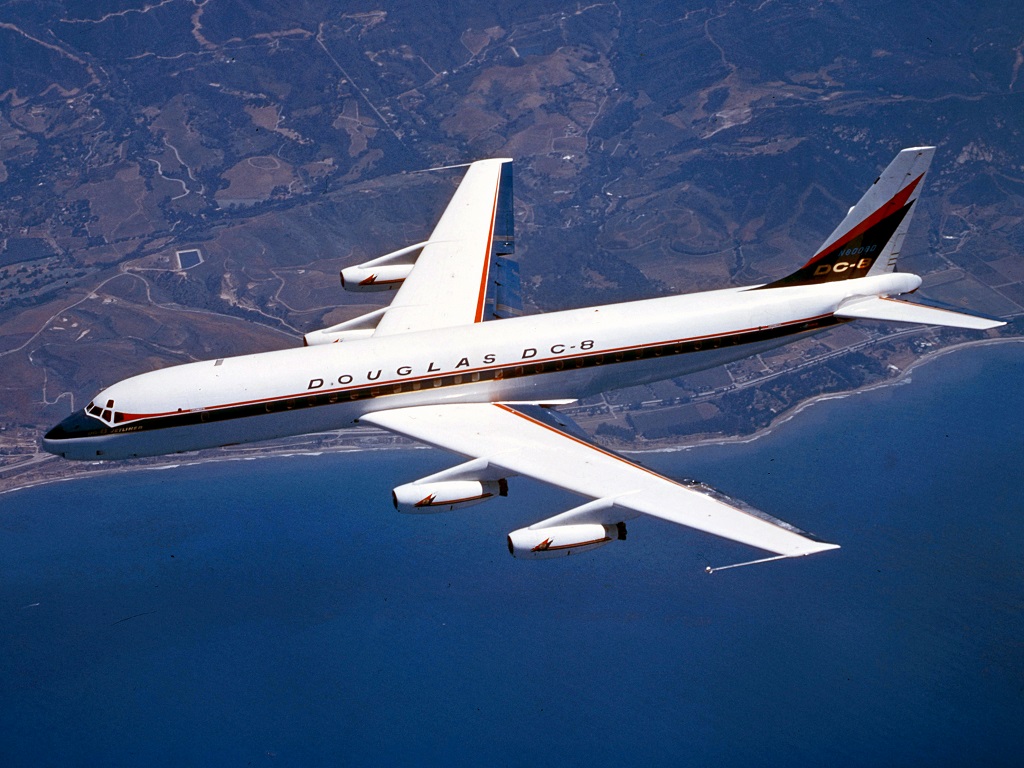

The story of the magnificent Douglas DC-8 is not so much a story about an airplane but rather a story about a dynasty, trust, and integrity.
The dynasty – of the Douglas Aircraft Company, the trust – by its founder that long-time and loyal engineers would deliver and the integrity – that design shortfall problems would be fixed.
The story of what Richard G Hubler in his book Big Eight calls the “last great airplane” started in 1951. At that time, American Airlines chief and longtime friend of Donald Douglas Snr (Don Snr), Cyrus R. Smith pressured the Santa Monica aircraft builder to build a longer-range version of the hugely popular DC-6 series.
Smith wanted to be able to fly non-stop across the USA westbound and Lockheed was promising yet greater performances from its Super Constellation.
Douglas designers, however, were mulling over a jet transport using the new civil JT3 engine, which was being developed from the military J57. While clearly, the future lay in jet transports, the reliability and fuel consumption of jets were not satisfactory at the time.
Don Snr told his then VP of Engineering Arthur Raymond that a civil jet transport in 1952 “would not have been a very good aircraft.” Don Snr was also concerned that airlines had invested heavily in piston engine transports and needed time to digest that investment.
And in 1951 Douglas dominated world airlines with one advertisement claiming that twice as many people flew on Douglas airplanes than on all others combined.
READ: The art of advertising the DC-8
With Smith ordering 25 – and thus paying the development costs – Douglas announced the DC-7 model in December 1951. The die was cast. Douglas moved engineering talent and resources into the DC-7 model.
The year was another blockbuster for Douglas with record sales and the certification of what would become the benchmark of four-engine piston airplanes – the DC-6B.
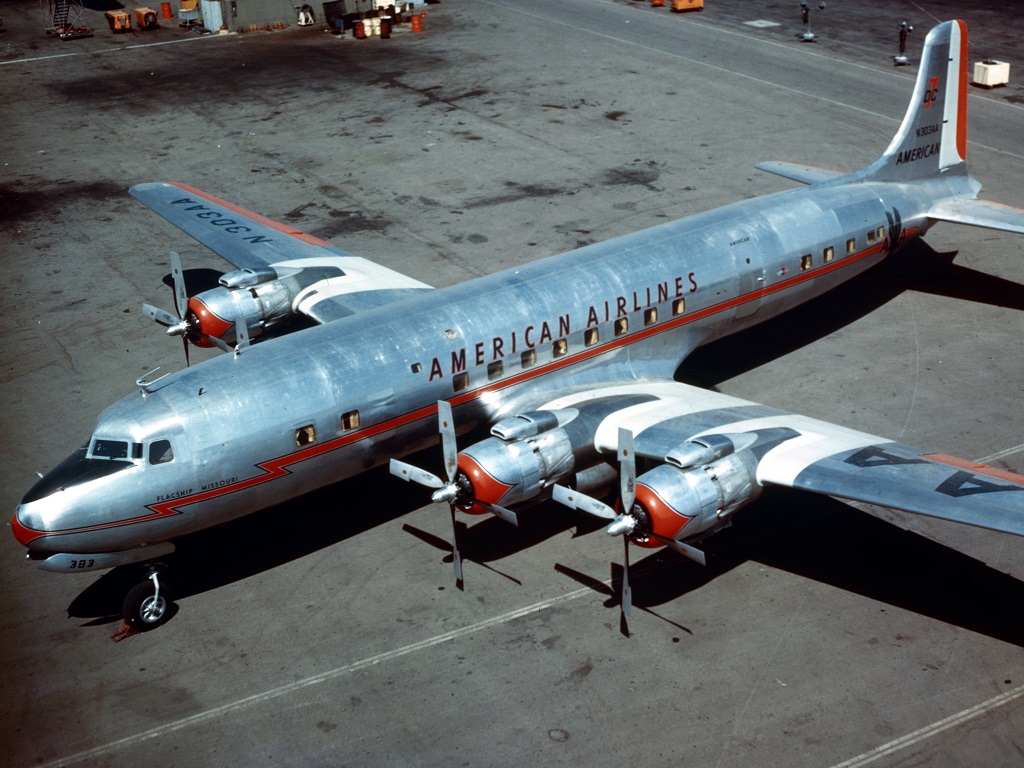
Douglas committed to the DC-7 for American Airlines in 1952 thus diverting resources away from its jet design. Boeing Historical Archives
In 1952 however, the USAF started talking about a military tanker to replace its KC-97 tankers. In June 1952 Douglas set up a design office to study the emerging USAF requirement and airline applications.
On Feb 1, 1953, Douglas told stockholders that more than $1 million had been spent on the project. But to the north, Boeing’s Bill Allen gambled $16 million in 1952 on a prototype to secure the USAF tanker order.
Back in May 1950, Wellwood Beall – VP of Engineering for the Boeing Aircraft Company – flew to England on the delivery flight of the last BOAC Stratocruiser. While in England, he saw the De Havilland Comet and recognized that the future of commercial aviation was in the jet-powered airliner and saw a great opportunity for Boeing to overcome Douglas’ lead in airline aircraft sales.
In a meeting in April 1952, he convinced the Boeing board. The Boeing jet transport program was underway.
And contrary to popular myth there was nothing secret about what Boeing was doing. It was all written up in its 1952 annual report for all to see.
The late Harold Adams, the retired Chief Designer of the Douglas Aircraft Company who worked on the DC-8, told Airways that “Boeing had several advantages over Douglas. Boeing had already designed, built, and flown two big swept-wing jet aircraft, the B-47, and the B-52.
The B-52 made its first flight in April 1952 powered by the Pratt and Whitney J-57 – a jet engine suitable for airline transport.” Adams also adds that “Boeing was the USAF’s only supplier of aerial refuelling tankers with the KC-97 and the only one with refuelling boom experience.”
Boeing was well aware of the USAF’s problem that the tankers were 200 miles per hour slower than the B-47s and the B-52s and in the Cold War environment of the 1950s, this was considered a major weakness.
In the touchy environment that existed at the time, the USAF was forced to have slower piston-engined tankers on station mid-ocean all the time “in case” of a scramble emergency for the bombers.
A jet-powered tanker, flying at the same speed as a combat aircraft, would eliminate this problem.
The USAF Secretary Harold Talbot asked for proposals for a jet-powered refuelling tanker of about 250,000 pounds gross weight in June 1952. The race was now in the open. While much is made of Boeing’s secrecy building the 367-80, Douglas was actively talking to airlines about its jet transport proposals.
The chief engineer was Ivor Shogran but in the background pushing for a jet transport was Don Douglas Jnr, who was anxious that Douglas did not slip behind Boeing. A number of models were suggested – all five across – seating between 80 and 110 passengers.
The over-water version sported pylon-mounted fuel tanks and had a range of 4,000 miles. By the end of 1954, Douglas had expended over $3 million and 250,000 hours on the DC-8 and had built a mock-up.

Mock-up of the Douglas DC-8.
Boeing rolled out its Dash-80 on June 14, 1954, as both companies finalized jet tanker proposals. While Boeing had a prototype, there was no great concern at Douglas according to former Douglas engineer and salesman Terry Waddington.
In his superb book Douglas DC-8, Waddington recounts that “the general feeling at Douglas was that the government would order a jet tanker from more than one manufacturer.” This was based on the previous purchases of transport aircraft from both Douglas and Lockheed.
Waddington recalls that on one occasion Don Douglas convinced the Secretary of the Air Force Harold E Talbot, that an order for the Douglas C-118 would be unfair to Lockheed and that the USAF ought to buy a similar number of the C-121 from Lockheed to which Talbot agreed.
Thus it was a real shock for Douglas when in February 1955 Talbot – pushed by USAF General Curtis Le May – ordered 21 KC-135s from Boeing before the technical evaluation was completed.
Don Douglas appealed to Washington at the highest levels but to no avail. Douglas was on its own but it was in extremely good shape. For the year ending November 30, 1954, Don Douglas reported to shareholders that “in most respects, 1954 was the finest year in the history of the company.”
Sales, jobs, earnings, and dividends reached post-war highs. All bank loans were paid and the company had a robust $100 million line of credit and a backlog of just over $2 billion. In 1954 Douglas was able to claim that it still delivered almost half of all airliners. Interestingly, 82% of Douglas’ sales were in fact for military fighters and bombers, including the licensed production of Boeing’s B-47.

The Douglas executive team with a model of the DC-8. Harold Adams is in the centre back row and Don Douglas is directly in front of him seated. Boeing historical archives colourized by Benoit Vienne
Douglas announced the go-ahead of its DC-8 design on June 7, 1955, and development costs were estimated at $450 million. The aircraft was to be powered by four JT3L engines rated at 11,000 lbs thrust.
The range was quoted as at least 3,700 miles with 125 passengers. In its coverage of the announcement, Aviation Week claimed that the Douglas move was prompted by the belief that they would have a clear shot at the commercial jet market with Lockheed building the Electra for American Airlines and Boeing tied up with the jet tanker business. Boeing, of course, had other ideas.
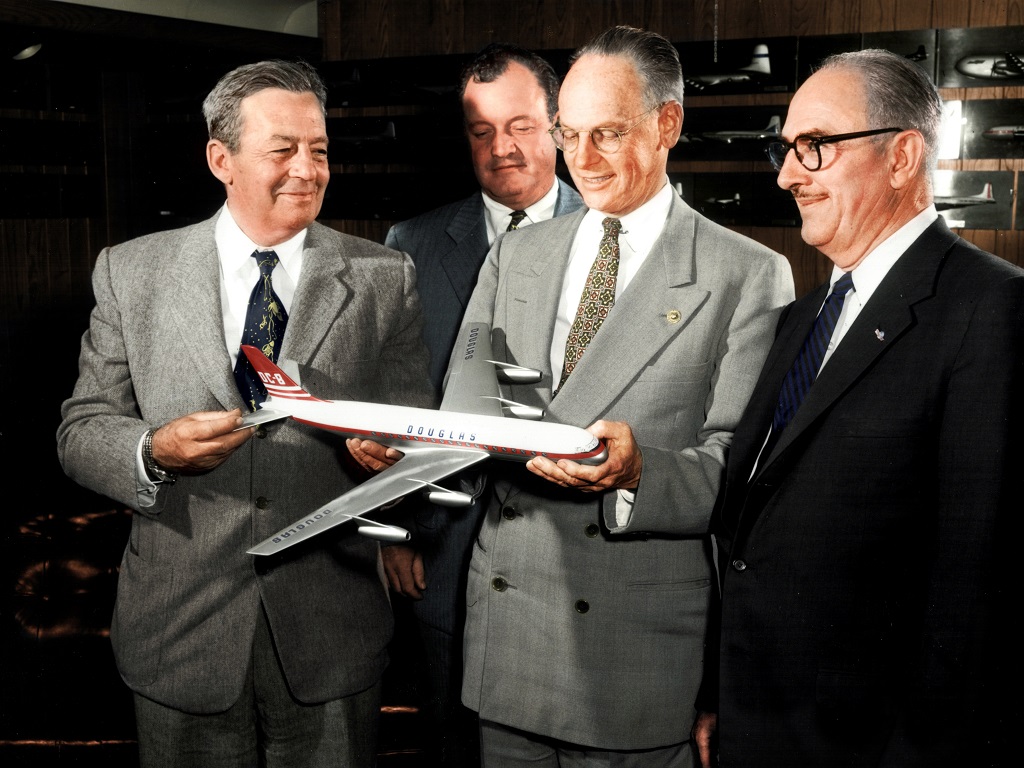
Don Douglas Snr, Nat Paschall, Arthur E. Raymond, and Ed Burton with a model of the DC-8.
The first customer to announce its intention to order the DC-8 was not Pan Am as is oft-quoted but Miami-based National Airlines which declared its order for six in August 1955. The pivotal buy, however, was Pan Am’s famous October 13 announcement for 25 DC-8s and 20 707s.
A few weeks later, in a spectacular announcement, Waddington recounts in his book that Don Douglas invited executives from 20 world airlines to Santa Monica after the IATA AGM in New York and with United Airlines’ Pat Patterson announced an order for 30 DC-8s – after Boeing declined to widen the cabin of the 707 to six across.
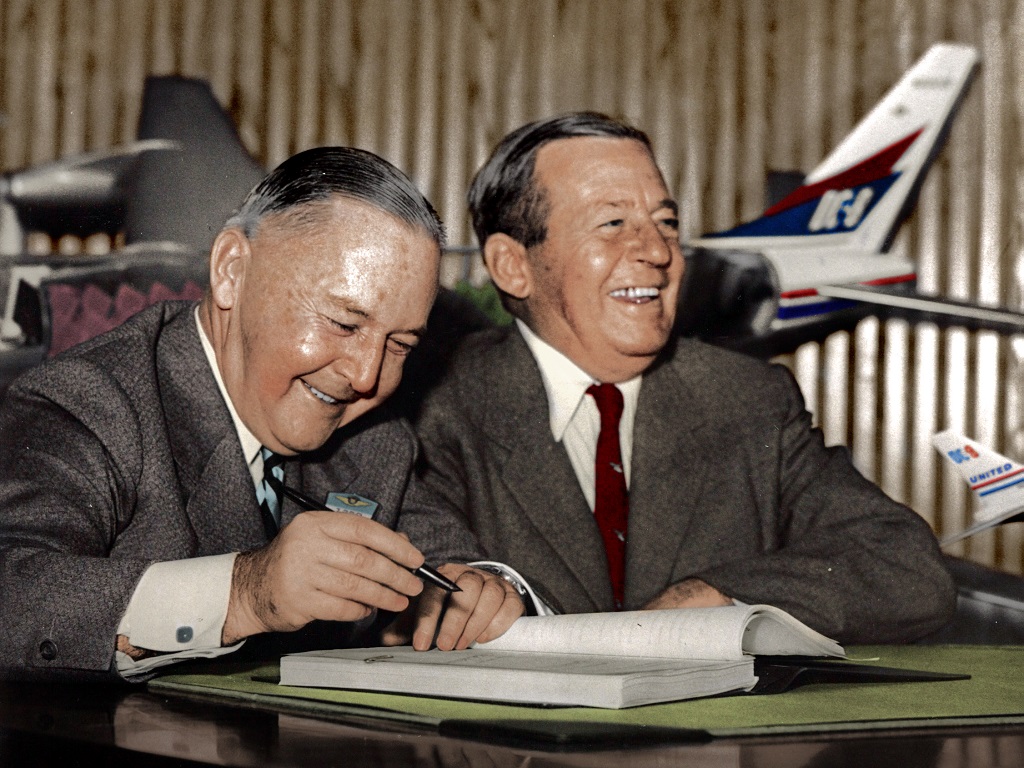
Bill Patterson signs for 30 DC-8s with Don Douglas. The score on that day was DC-8 ahead with 61, Boeing 707 with just 20. Picture colorized by Benoit Vienne
But the smile on Don Douglas’ face was soon to dim. Next to order big jets was Douglas’ longtime friend Cyrus Smith’s company, American Airlines. Mr Smith had previously been a loyal supporter of Douglas Aircraft. He had earlier talked Douglas into deferring a jet transport in favour of the DC-7 series, but in the end, Smith went for the 707.
In a savage ironical twist, Smith cited the fact that “Boeing had a jet flying” as a major reason for American’s decision. Dan Beard, American’s then-Assistant VP of Equipment Research, provided more insight to the American Airlines choice in Martin Caidin’s 1959 book on the 707.
“The 707 had incalculable advantages in being based on previous experience with three different high-lift, large-wing, swept-wing, long-range airplanes –the six jet B47, the tremendous eight jet B-52, and the 707 prototypes.”
Added to this was the fact that by virtue of its tanker business, the 707 was around $500,000 (10%) less than the DC-8. The deal clincher for American was Boeing’s agreement to widen the fuselage of the 707 by 10 inches to match the DC-8.
Interestingly, American’s engineering experts took a dim view of the DC-8’s wing which had a sweepback of 30 degrees while Boeing had gone for 35 degrees. At the time, Beard explained that “this may not seem like much but it is vitally important. The sweep and thickness of the 707 wing made it inherently twenty miles per hour faster in its basic design than that of the DC-8.”
Putting that decision further into context of the era, American then committed to the Convair 990 on a promise of even more speed and its strategy was to have all first-class passengers fly the CV990 and economy class on the “slower” 707-such as the allure of speed in the 1960s.
The DC-8 wing, in fact, was to be its Achilles heel but there were many of those in the DC-8 program, claims Harold Adams. “The management of the DC-8 program was another example of management by “blind faith” that had characterized the management of the earlier, successful Douglas transport aircraft programs, but this time the players were different,” notes Adams.
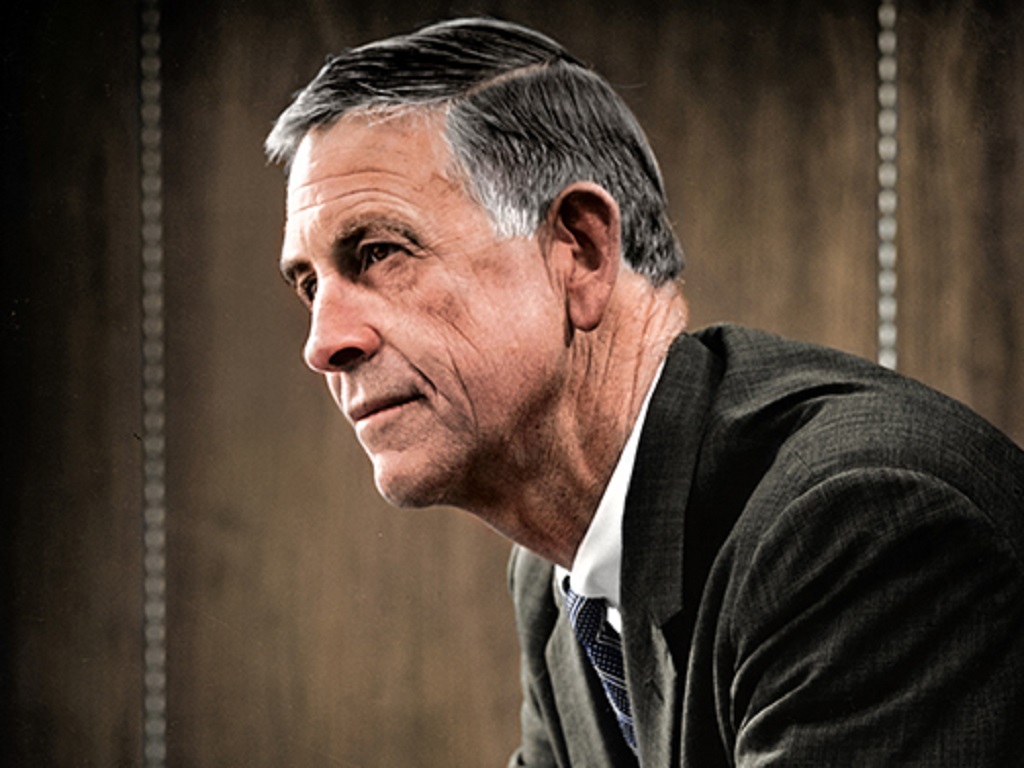
Harold Adams. Boeing Historical Archives colourized by Benoit Vienne
Adams points the finger at Arthur Raymond who was at the time VP of Engineering over three engineering departments – El Segundo, Long Beach, and Santa Monica, where the DC-8 was being designed.
“He was never an aggressive leader and backed away almost completely from supervision of the design work being done in these departments. This left the three chief engineers to be the sole managers of the design work in their departments, without any supervision from above.”
Compounding that lack of direct supervision was the appointment of Ed Burton’s Santa Monica division to oversee the DC-8 design. Adams claims that Burton was always on the lookout for radical solutions to problems – which led to a disaster with the DC-8 wing.
According to Adams, “The wing of the DC-8 was entrusted to “Kleck” Kleckner, who had found an airfoil designed by the N.A.C.A. several years before that promised to have lower drag at high Mach numbers than the conventional airfoils.”
Adams explains that “conventional airfoils kept their drag low at high Mach numbers by keeping the airflow over the upper surface of the wing below the speed of sound avoiding the formation of “shock waves” over the airfoil.
This limited wing swept back at 30 degrees to about M .80, and with a sweepback of 35 degrees, to about M.85. If M.85 could be achieved at a 30-degree sweepback, there would be a considerable advantage to the airplane in lower wing weight and better low-speed characteristics.”
Adams adds that “the N.A.C.A. super-critical airfoil proposed by Kleckner for the DC-8, promised to give low drag at speeds of M.85 with 30 degrees of sweepback, through the use of a blunt nose airfoil designed to have a shock wave near the leading edge, but with a recombined airflow behind the shock that eliminated the high drag associated with the shock wave.”
But the design problem here – unrecognized by Ed Burton and Kleckner -- was that this airfoil had never been proven in flight. Adams explains in his book that “In 1955, calculations and wind tunnel tests did not always correlate with flight tests.” If the “super-critical” airfoil failed to live up to its promise, the drag could be higher than the drag of a conventional airfoil and thus the drag rise on a 30 degree swept wing could start as low as M.75.” As history would show, this is exactly what happened.

Douglas Dc-8s on the flight line at Long Beach. Photo colorized by Benoit Vienne
Adams rues the fact that an early look at this problem could have been achieved by “flight testing a half size DC-8 wing on a Douglas A3D US Navy attack airplane which had about half the wingspan of the DC-8.” Douglas had guaranteed its customer airlines Mach 84 – so the seeds for disaster were sown.
However, part of the design philosophy for the DC-8 wing sweepback was explained by Ivar Shogran, the DC-8 project engineer, who told Aviation Week in 1955 that “every effort has been made to retain as close as possible the landing, take-off, and ground handling characteristics of the current (DC-7) transports.”
This was to reduce the transition training costs for pilots and maintain safety levels of the day. The DC-8 across the fence speed was only going to be 5kts faster than the DC-7 and the stall speed was 4kts faster.
Former Douglas President (1968-72) Jackson McGowan agreed with Adams on the design leadership of the DC-8. “Nothing was getting tied down. Everyone was doing their own thing,” McGowan recounts. McGowan said that there was extensive waste on the program.
“We (Douglas) spent $10 million developing our own seat for the DC-8, which was no better than what we could buy off the shelf.” McGowan was not initially involved with the DC-8 program but was brought in later to try to get it back on track.
“Ed Burton wanted to replace the guy directly responsible for the problems with myself but was such a nice guy he just couldn’t do it. Art Raymond discussed this with the old man (Don Snr) and thus I was made Assistant VP of Engineering on the DC-8 and took over the program from the side.”
In fact, the problems of the DC-8 led to serious illnesses for Raymond who was forced to resign. But well away from the design office and manufacturing problems, the reputation for Douglas airplanes was such that, despite the delivery lead of Boeing, airlines were signing up for the DC-8.
In fact, as late as 1959, Douglas was able to boast that 19 airlines had ordered DC-8s – more than any other jetliner. And to satisfy airline demands for the new jets, Douglas had embarked on such a frantic production build that ship 14 for Delta was completed two weeks before the DC-8’s first flight. That production rate was to cause problems later.
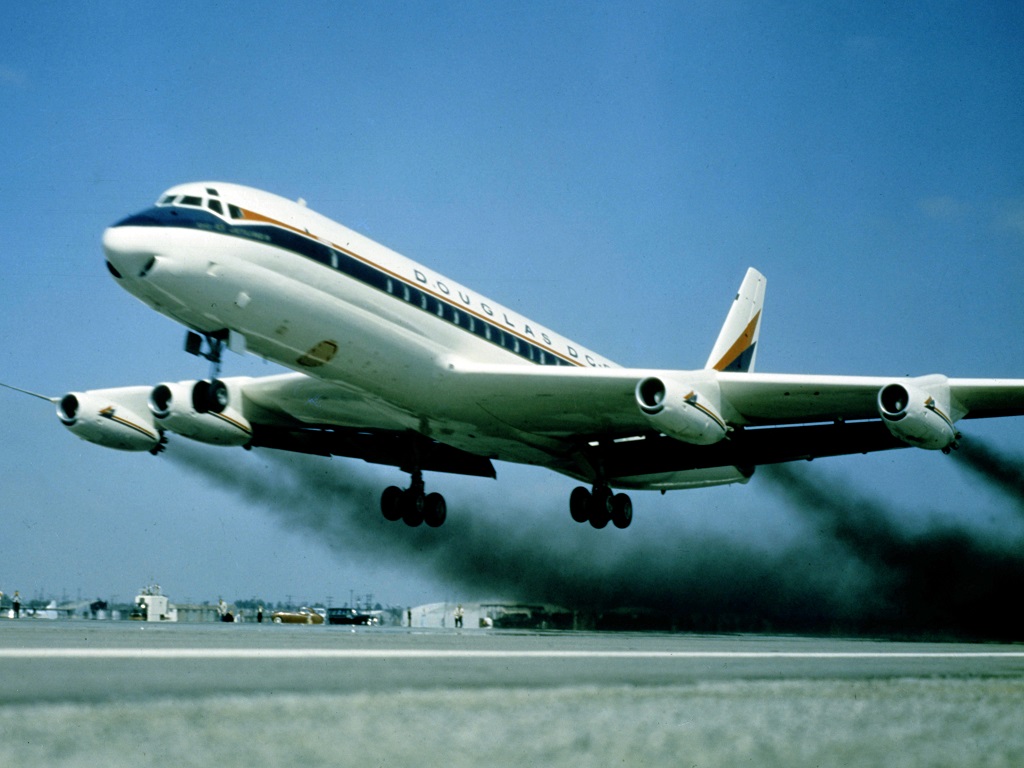
Douglas DC-8 takes to the air in May 1958. Boeing Historical Archives
It was not long after the first DC-8 took to the air on May 30, 1958, in front of 95,000 employees and friends, that serious drag problems surfaced – 13% above estimates and 10% above guarantees – with both the wing/engine pod combination and the basic wing shape.
Adams recalls that the “initial JT3C powered DC-8s had an (economical) speed of only Mach .798 – far below the guaranteed Mach .84.” A series of modifications were introduced that included wing slots, wingtip extensions, and altering the nose profile of the wing.
Due to the rapid build-up of production to meet delivery demands, the problem for Douglas was that the major modification of re-profiling the nose of the wing could not be introduced until ship 148, although the modifications were available as a refit.
McGowan recounts the problem. “The modifications helped but did not solve the situation and Don Snr offered airlines a cash settlement of $230,000 per aircraft.” But while cash settled the airlines’ ire, the loss of performance in most cases did not solve the range shortfall. Don Snr promised to keep working on the problem and that saved many orders,” notes McGowan.
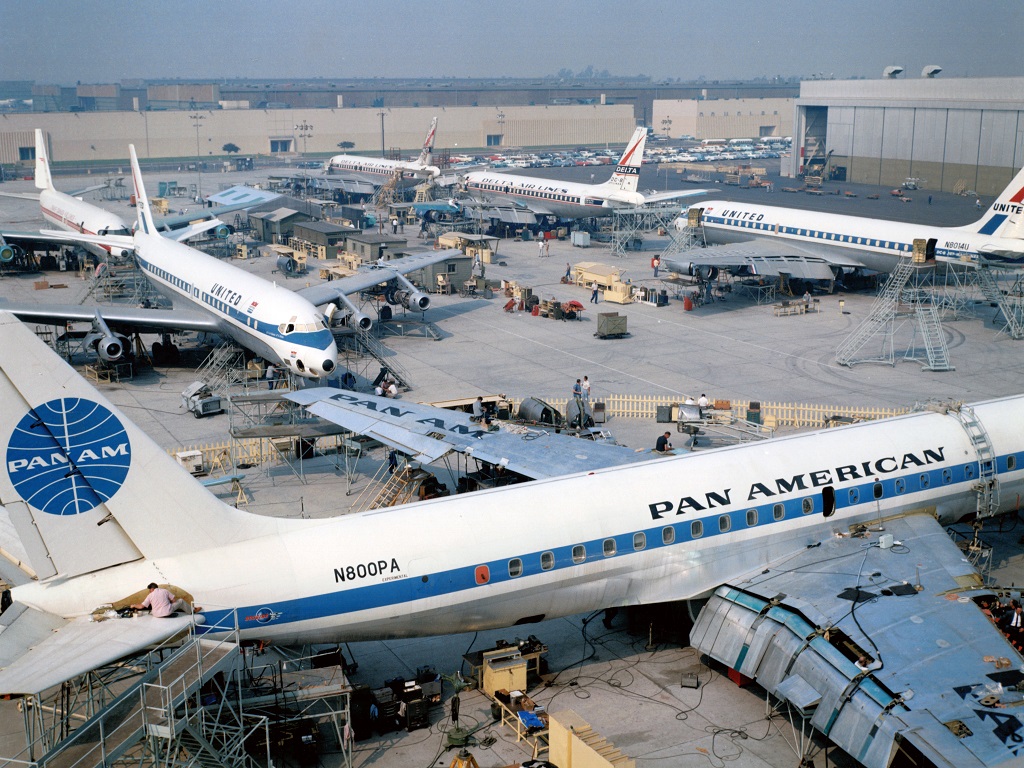
Fixes to reduce drag on the DC-8 meant many hours of outside work. Boeing Historical Archives
Adams adds that “in the effort to increase sales between 1958 and 1965, many models and changes within models were introduced, after the initial DC-8-11 with the 13,500-pound thrust JT3C engine and the DC-8-21 with the 16,800-pound thrust JT4A engine and this drained engineering resources”
Most notable of the advances was the JT3D turbofan engine, which in February 1960, was announced by McGowan, who was then VP of Commercial Programs. This engine development with its significant reduction in fuel consumption was the key to the development of a fix in the DC-8’s performance.
But there were those in the Douglas Aircraft Company who thought that the DC-8 should be abandoned. The late Don Jnr told the author in 1997, that “there were those who thought we should cut our losses and exit the civil market.”
Don Jnr and McGowan would have none of that – a view also shared by Don Snr. Don Jnr had been made President of Douglas in October 1957 and between that date and 1962, 10 VPs resigned or were fired in what Fortune magazine headlined the “Bloodbath at Santa Monica.”
In 1961 Don Jnr ordered the DC-8 program go on and at the same time, made sweeping changes to the company’s management structure. McGowan was made VP Aircraft Division and Charles Able VP of Missiles and Space. In May 1958, before the first flight of the DC-8, Pratt and Whitney was converting the “pure jet” JT3C into the “fan jet” JT3D.
This engine promised major gains in takeoff thrust and range – compared with the JT3C, and major range gains –compared with the larger JT4. Ship 1 retrofitted with the JT3D fan jets flew on December 20, 1960, and thus the DC-8-50 was born.
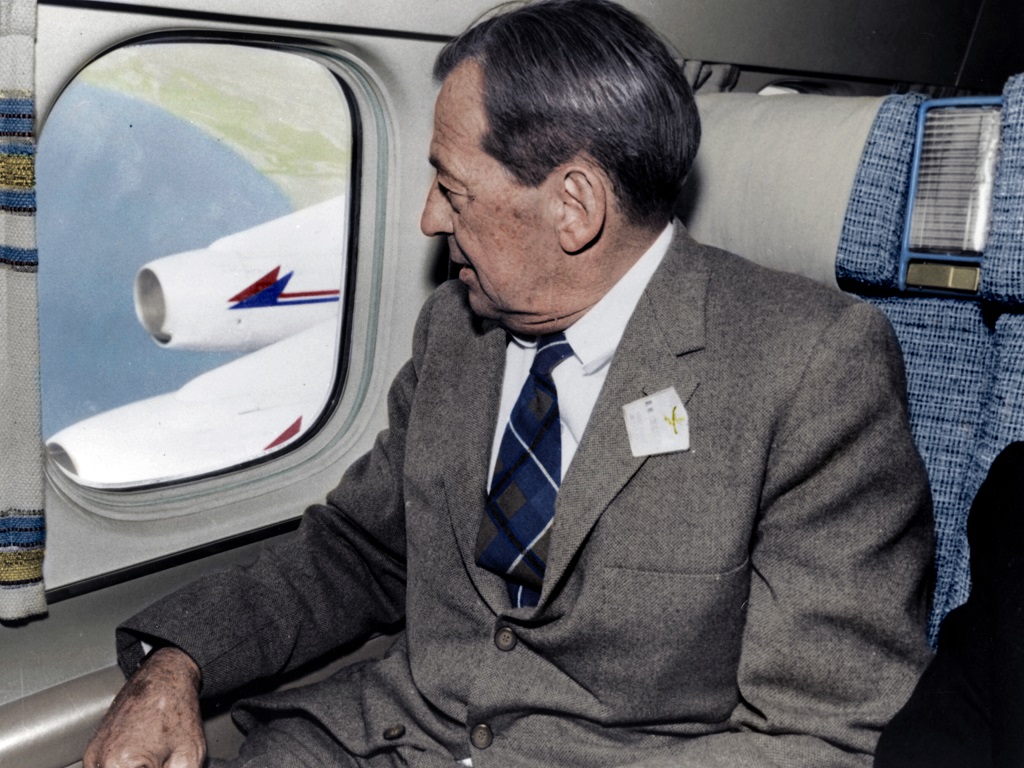
Donald Douglas Snr takes his first DC-8 ride. Boeing Historical Archives colourized by Benoit Vienne
Adams explains that with the Series 50 DC-8 and the turbo-fan engine, the DC-8’s payload was 80,000 lbs but it was space limited to just 40,000 lbs. A stretch was easy. And while the stretch was being considered Douglas test pilots were proving that the DC-8 left the competition behind.
On August 21, 1961, during a test flight to validate wing design improvements, a DC-8-43 powered by Rolls Royce Conway engines destined for Canadian Pacific exceeded Mach 1 in a dive from 52,090 ft to 42,000ft.
Subsequent DC-8 test flights set altitude and range records that were never bettered by first-generation commercial jets. But that performance had to be turned into orders. McGowan recounted in a 2004 interview with the author, that his team had been working on a variety of improvements for the DC-8.
“We needed slimmer pods and major wing modifications,” he told the author. “Don Jnr told me that we had to achieve a 7% performance improvement in range to go ahead.” The numbers started to roll in and key European customer SAS wanted the range to fly Copenhagen – Los Angles with a full payload.
Boeing was knocking on the door with a deal to replace the airlines DC-8s and Caravelles with 707-320s and 727-100s. SAS was happy with its Caravelles but pressured Douglas for a better DC-8.
McGowan recounts that he had fellow Douglas engineer Harry Hjorth put the finishing touches on a new model in a hotel room in Stockholm. “The DC-8s wing would have another 3 feet added and, combined with the slimmer engine pod design, would give a 6,000nm range.” To add the few extra seats required by SAS, an 80-inch plug was added (40 inches fore and aft of the wing).
McGowan recalls, after gaining an order for four Model 62 DC-8s from SAS, he called up Bill Mentzer VP of engineering at United Airlines. “I said to him, ‘We have a great new airplane with three more rows of seats and he barked back at me, ‘What the hell have you done for us? You are up there (in Stockholm) giving away your shirt for someone who is going to buy just four airplanes – what the hell are you doing for us?’
“So that is how we launched the stretched DC-8,” notes McGowan. The program was formally launched in April 1965 with the three models seating between 189 and 269 passengers.
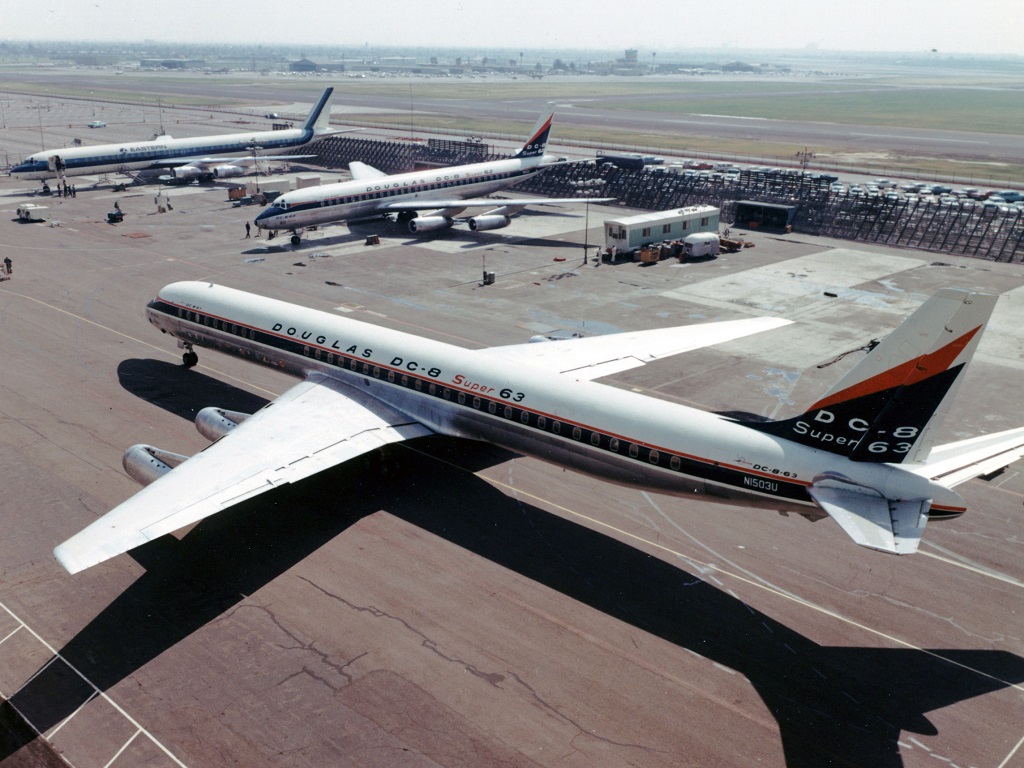
The stretched DC-8s gave the program a new lease of life. Boeing Historical Archives.
Adams notes that “all three versions included the early drag reduction improvements including the sharp-nosed 4 percent leading-edge extension and some interior improvements. Cockpit improvements included a cockpit and instrument arrangement similar to the DC-9.
Cabin improvements included baggage racks, overhead passenger convenience units, and pull-down window shades similar to the DC-9. To permit rapid evacuation of the increased number of passengers, two emergency evacuation exits were added just aft of the wing.
The air conditioning system capacity was increased to handle the larger passenger loads, the electrical generators were increased from 20 to 30 KVA each and the belly cargo doors were increased from 36 x 44 inches to 56 x 60 inches to permit more rapid loading of passenger bags and cargo.”
The -61 and -63 models had a fuselage extension of 200 inches ahead of the wing and a 240-inch extension aft of the wing that increased the passenger capacity to 269 passengers, although most airlines used a 249 passenger seating arrangement.
The -62 as noted had two 40 inch plugs but, with the -63, featured a host of aerodynamic improvements. “The engine pods were changed from the earlier pods with side outlets for the fan air, to a “long duct pod” that exhausted the fan air at the rear end of the pod. This gave a more efficient and quieter engine installation.
The engine pod was mounted farther forward of the wing on a new pylon. The new “underwing” pylon had no portion of the pylon above the wing leading edge, giving lower drag and better wing airflow,” notes Adams.
A 3-foot extension was added to each wingtip, reducing the induced drag in the cruise. Adams recalls that while the DC-8 was now the ultimate airliner of its day, it had one serious drawback that still hampered sales.
This was related to the aircraft’s large windows that were spaced at 40 inches. When the DC-8 was designed, the head of the Structures Design Group in the Douglas engineering department was Ed Harpoothian. “Harpo – as he was known – was the genius who created for Douglas the most long-lived structures the industry has ever seen.
For the DC-8, (with the Comet experience in mind) to prevent fatigue cracks from progressing past the fuselage frames, he used titanium strips to act as “rip stops” at every frame.
But one of his requirements for a long-lived fuselage structure was to put windows between alternate frames – at 40-inch spacings.” Adams said that Ed Burton gave Harpo his total support and went along with this design, even though the 707 had windows at every frame – at 20-inch intervals.
“Harpo was single-minded in his field of structural design and was never willing to compromise, even though he could have designed a long-lived fuselage with windows at 20-inch spacing, as shown by the structures of the DC-9 and DC-10,” says Adams.
When airlines reduced their seat spacing from the early standard of 40 inches in the late 1950s, the wider-spaced windows put the DC-8 at a significant disadvantage because some DC-8 passengers had no window alongside their seats.
Shortcomings notwithstanding, orders for the Super 60 series DC-8s flowed in, vindicating Don Jnr’s and McGowan’s faith in the design. But the challenge now was to move the DC-8, and its new smaller stablemate the DC-9, from popularity to profitability, as Fortune magazine so aptly put it in 1966.
Initially, recounted the late Don Jnr in 1997, everything went well. “In 1965 our profits rose as did our backlog (118%), which was the greatest since 1965.” The glory days of Douglas were returning as it rolled out the world’s largest jetliner the DC-8-61 on January 24, 1966. In 1965, 76 Super DC-8s had been sold compared to just 27 standard models in 1964.
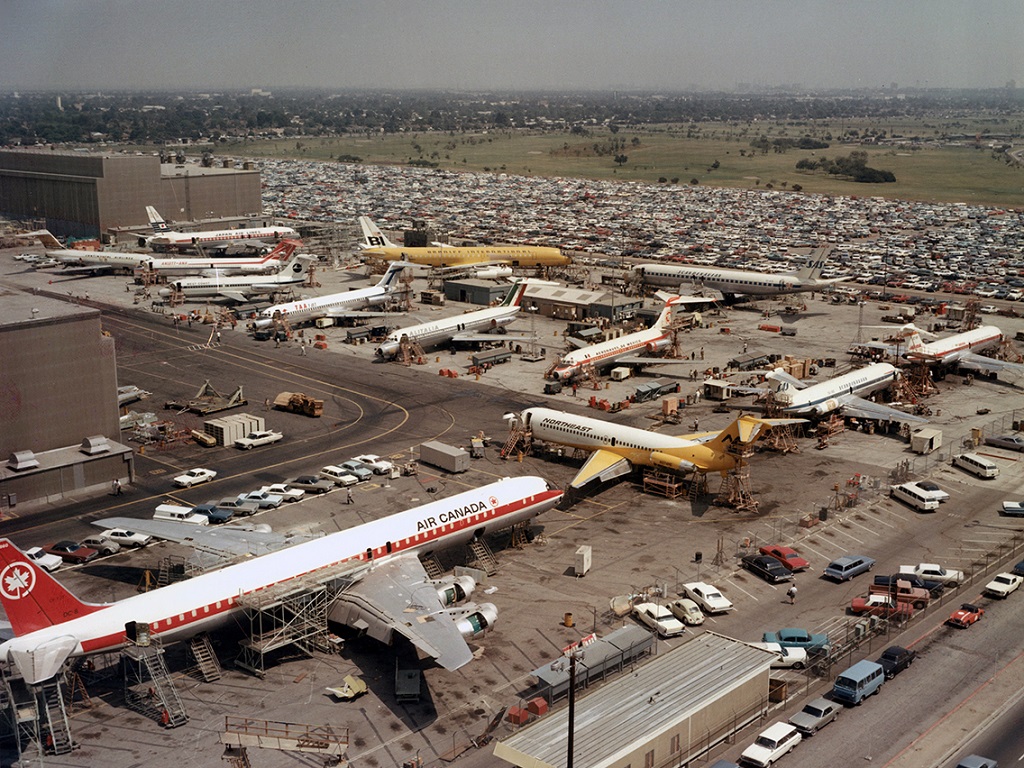
The success of the DC-8 and DC-9, the number of models, and parts shortages created chaos on the production lines which was to lead to the merger with McDonnell. Boeing Historical Archives.
However, 1966 was a disaster for the company, despite booking another 112 DC-8 orders and 181 more DC-9s – the best peacetime sales ever achieved by the company. The problems are well documented and were due to a number of factors – the rapid production build-up of a multitude of models, the shortage of skilled labor, and the chronic shortage of parts due to demands of the Vietnam War.
At one stage, DC-8s were being “completed” with 25,000 hours of open items because of parts shortages. Some also cite Douglas’ policy of using a single source for many parts as a factor. Don Jnr conceded to the author that “Jack and I were too gung-ho” in their battle to regain market share from Boeing.
Another aspect of the problem is revealed by Wilbur Morrison in his touching book A heart with Wings (Iowa State University Press). Morrison was head of PR at Douglas during the period. He recounts that “when the Aircraft Division was formed in 1960, Harold Hynd, perhaps the company’s most skilled production, and cost-control expert, refused to accept the deputy position under McGowan.
Both Douglases joined McGowan in pleading with Hynd to change his mind, but he stubbornly refused. Hynd had expected to replace Ted Conant as Senior VP of Manufacturing when Conant retired, and when the job went to another man he became so incensed that his bitterness against the company’s top officials turned into an obsession.”
Morrison adds that Hynd had a strong following of managers who highly respected him and many left the company. The problems combined to force a merger with McDonnell Aircraft Company of St Louis, the extremely successful military and space manufacturer. The merger was announced on January 1967 and the “first” McDonnell Douglas (MDC) aircraft – the DC-8-63 – was rolled out on March 6.
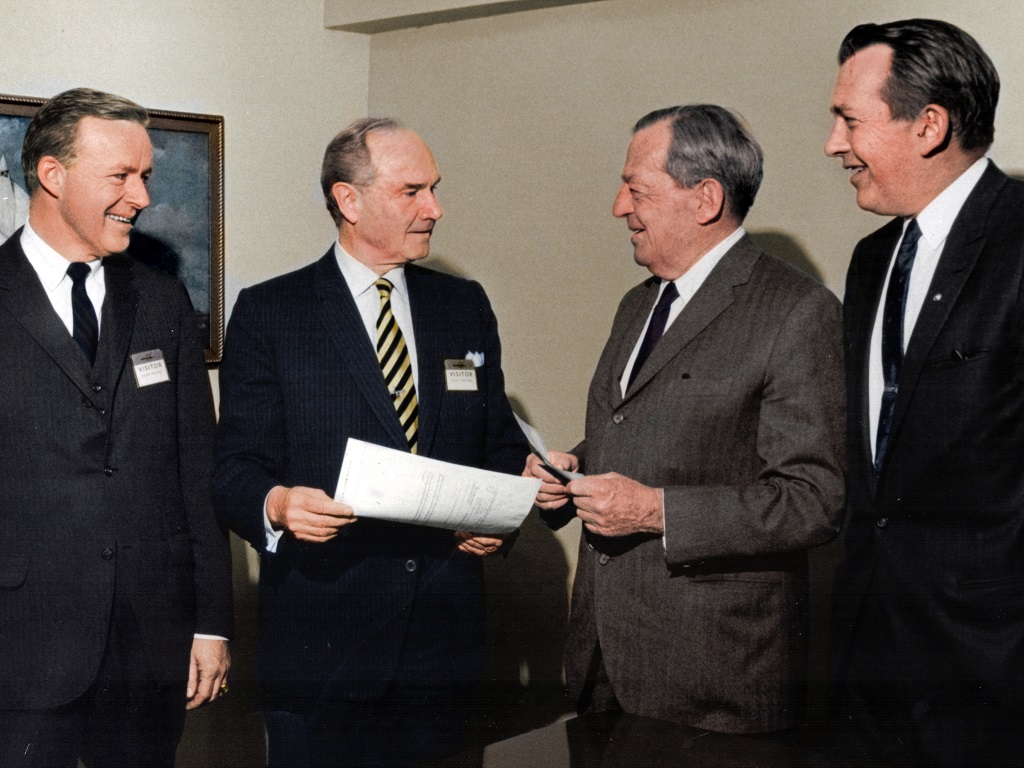
L:R David Lewis - President of McDonnell Aircraft, James McDonnell,- Chairman of McDonnell Aircraft, Donald Douglas - Chairman of Douglas Aircraft Company, and Jnr - President of Douglas Aircraft Company.
The impact of that merger was far-reaching on the DC-8. During 1967, the flight test department was able to certify and deliver the first DC-8-62, DC-8-63, DC-8-61CF and DC-8-62CF, while the sales department sold another 73 Super 60 series and three -53s were ordered.
Better still, the production department performed a near miracle with 195 DC-8s and DC-9s delivered – well up on the 100 the year before. Open items on the DC-8 fell dramatically to just 50 hours.
Despite the lure of the DC-10, the sales team chalked up another 35 sales in 1968, while delivering DC-8s at a record rate of basically two per week for 102. All those deliveries were either on, or ahead of, schedule.
However, airlines became focused on wide-body solutions with the 747, DC-10, and Tristar causing orders for the DC-8 to become a mere trickle early in the 1970s. At the end of 1971, McDonnell Douglas announced that the last of the 556 DC-8s (a -63) would be delivered in mid-1972 to SAS – ironically the airline that had kicked off the Super 60 program.
While McGowan retired from McDonnell Douglas in 1972 as President of Douglas Aircraft Division, his involvement in the DC-8 still had another lease of life with the Super 70 Series program. New noise standards threatened to cut short the life of the DC-8s in the late 1970s with tens of thousands of hours of structural life left.
The Super 60 series DC-8s were prime re-engine candidates. MDC looked at several options including one to fit de-rated DC-10 engines on the Super 60 DC-8s. In 1975 General Electric started talking to airlines about fitting the new very quiet 22,000lb CFM-56 to the DC-8 but the noise regulations were still fluid and the airlines preferred to wait.
In March 1977 the US Congress outlined new regulations for compliance with Stage 3 by 1985. Responding quickly, McGowan formed Cammacorp in 1977 to act as a management contractor for the retrofitting of DC-8s. Talks started immediately with GE on the CFM-56 engine.
Interestingly, McGowan recounts that although MDC had originally been lukewarm, he suddenly found that in May 1977 the manufacturer was talking to DC-8 operators about retrofitting.
Complicating matters, Pratt and Whitney announced its JT8D-209 rated at 19,000lbs. The P&W installation – which would be handled by the engine maker – was the simplest, but Flying Tigers was concerned about its night cargo operations with thrust cutbacks after take-off becoming a probability.
MDC dropped out of the management role and, after lengthy negotiations, McGowan was able to announce in May 79 that he had 78 orders from seven airlines for the CFM-56 powered Super 70 series.
Cammacorp contracted MDC Long Beach for engineering support while conversion work was completed by MDC’s Tulsa plant, Delta, Air Canada, and UTA Industries. In all, 110 DC-8s were converted when the program wound down in 1986.
The Super 70s were about 70% quieter than the Super 60 Series and between 18% and 25 percent more fuel-efficient than the JT3D, depending on the model. As late as 2004 there were still 159 DC-8s – mostly Super 60 and 70s – still in active operation around the globe.
However, the GFC and fuel hikes put paid to the working life of the DC-8 and by 2017 only a handful remain in active service with NASA and some relief organizations.
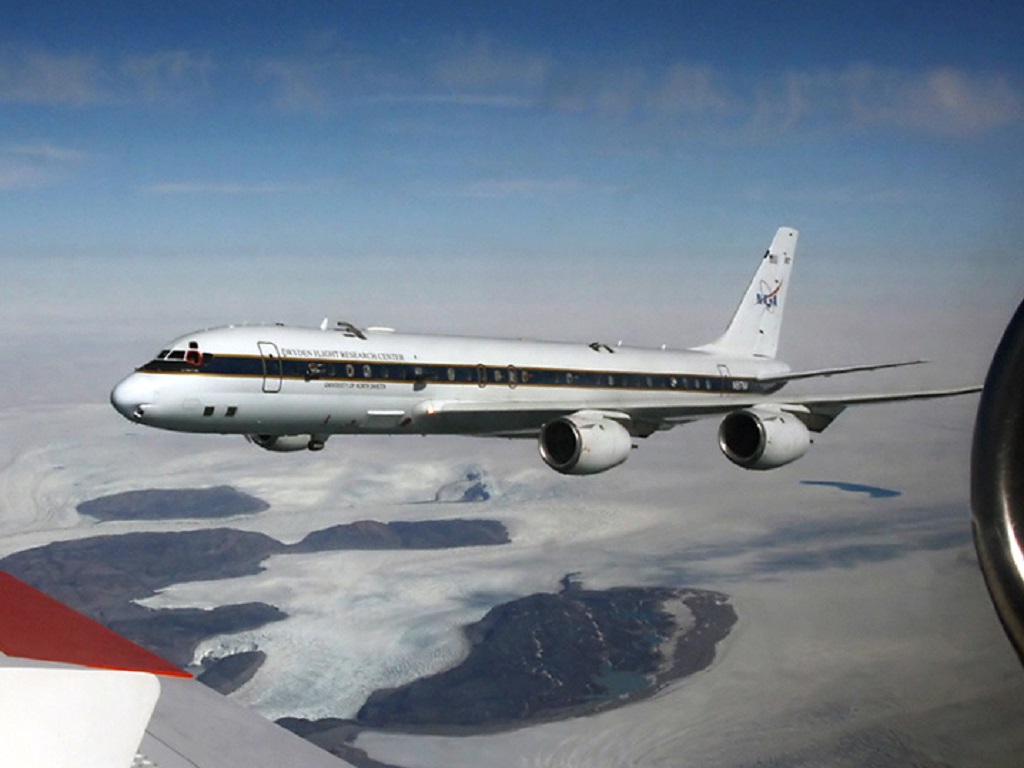
NASA still operates a DC-8 Super 72 for atmosphere testing
The last word on the DC-8 saga goes to Richard G Hubler, who wrote in his book The Big Eight that the DC-8 was “the last of the pure-blooded, thoroughbred line.”
He commented that what “streamline monsters” follow was of no concern for the DC-8. “By that time she will have placidly fulfilled her mission and retired to the pages of history to join her honoured ancestors. Men will have known her intimately and grown to love her, and she will have been faithful to them in her fashion.”
Sixty-plus years after those words were penned, the DC-8 is still a thoroughbred and admired by all who love aviation. She stops airplane lovers in their tracks wherever she goes.
Authors Note: A number of quotes attributed to Harold Adams were taken in an interview in 1997 while others are quoted with permission from the late Mr Adams from his excellent book “The Inside Story-The Rise and Fall of the Douglas Aircraft.” The author also assisted Mr Adams with the compilation and editing of that book.
Get the latest news and updates straight to your inbox
No spam, no hassle, no fuss, just airline news direct to you.
By joining our newsletter, you agree to our Privacy Policy
Find us on social media
Comments
No comments yet, be the first to write one.


